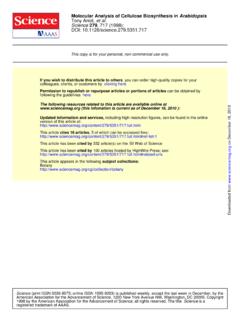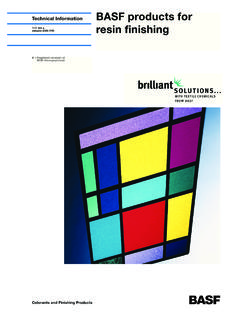Transcription of Coffee carbohydrates - SciELO
1 Braz. J. Plant Physiol., 18(1):165-174, 2006 Coffee carbohydratesRobert Redgwell* and Monica FischerNestl Research Centre, Lausanne, Vers-Chez-Les-Blanc, Box 44, CH-1000 Lausanne 26, Switzerland. *Corresponding author: This review summarises recent advances in the chemistry, physiology and molecular properties of Coffee carbohydrates with a particular focus on the cell wall polysaccharides. The results of detailed chemical studies have demonstrated novel structural features of both the galactomannans and the arabinogalactan polysaccharides of the green and roasted Coffee bean. For the first time immunological probes based on monoclonal antibodies for specific polysaccharide epitopes were used to reveal the patterns of distribution of the galactomannans, arabinogalactans and pectic polysaccharides in the Coffee bean cell wall.
2 Finally, the results of physiological and molecular studies are presented which emphasise the growing awareness of the potential role the metabolic status of the green bean may play in final Coffee beverage words: Coffea, cell wall, beverage quality, do caf : Este artigo sumariza os mais recentes desenvolvimentos nas reas de qu mica, fisiologia e propriedades moleculares dos carboidratos do caf , com um particular interesse nos polisacar deos presentes nas paredes celulares. Os resultados dos estudos qu micos detalhados demonstraram novas caracter sticas estruturais tanto nos galactomananos como nos polissacar deos dos arabinogalactanos do gr o de caf verde ou torrado. Pela primeira vez, estudos imunol gicos baseados em anticorpos monoclonais foram usados para revelar a distribui o dos galactomananos, dos arabinogalactanos e dos polissacar deos pect dicos na parede celular do gr o de caf.
3 Finalmente, os resultados dos estudos fisiol gicos e moleculares s o apresentados de maneira a sublinhar a influ ncia do status metab lico do gr o verde do caf na qualidade final da : Coffea, parede celular, qualidade da bebida, The importance of carbohydrates in Coffee can be attributed to not only their high concentration in the bean but also to the complex changes they undergo during the roasting process which contribute to the organoleptic appeal of the Coffee beverage. In this review we will focus on the Coffee carbohydrate literature of the last 5 years. Before this time, an excellent summary of Coffee carbohydrates was reported in the volume, Coffee , Recent developments (Bradbury, 2001). It included a detailed report of the low molecular weight sugars in green and roasted Coffee beans of many varieties of Arabica and Robusta, which will not be repeated in the present review.
4 In the last few years interest has grown in the physiology and biochemistry of green Coffee bean development and the role this could play in Coffee quality. This includes work to understand sugar metabolism in Coffee in relation to sink-source relationships during bean development. However, to date there is very little published literature relating to the carbohydrate physiology of Coffee . What there is will be covered in the present review but of necessity the major focus will be the polysaccharides of the Coffee bean cell wall, where significant advances in understanding their chemistry, biochemistry and distribution within the endosperm have been made in the last 5 status of developing grainsFree sugars: The driver for Coffee research has been to consider the various components of the Coffee grains as potential precursors of Coffee beverage flavour and aroma.
5 Whether focusing on the low molecular weight sugars or the polysaccharides, the great majority of such studies have been done on the mature grains of Arabica and Robusta Coffee . There is a lack of information on the evolution of M I N I R E V I E W166 Braz. J. Plant Physiol., 18(1):165-174, 2006R. REDGWELL and M. FISCHERthe carbohydrate profile of the grain during its growth and development and the postharvest stages of bean processing. The metabolic status of the green bean at these stages will affect the final chemical composition of the mature green bean and the influences which modulate this metabolic status are factors which impinge on Coffee bean quality. Rogers et al., (1999) conducted a study of the changes to the content of sugars, and sugar alcohols in developing grains from varieties of Robusta and Arabica.
6 The grains were harvested between 12 30 weeks after flowering (WAF) for Arabica and 18-40 WAF for Robusta. In the early stages of development, up to the halfway stage of maturation, glucose and fructose were the major free sugars with glucose consistently twice the concentration of fructose. Glucose levels were higher in the Arabica varieties (between 8-12 % dry weight) than in Robusta (2-4 % dry weight). At the end of grain development concentrations of glucose and fructose had decreased for both species to and % dry weight respectively, while sucrose at 5-12 % of the dry weight was essentially 100 % of the total free sugars in mature grains. A more detailed analysis in one variety of Arabica was done by separating the perisperm tissues from the endosperm and analysing the free sugar concentration in each.
7 The higher concentrations of glucose and fructose compared to sucrose in the early stages of development were always associated with perisperm tissue. In the endosperm even at the earliest stages of maturation, sucrose was the dominant sugar. The authors speculated that the catabolism of sucrose in the perisperm would be consistent with the requirement by the tissue for an increase in osmotic pressure to enable both the initial expansion within the locular space and a sink function. Results of the analysis of sugar alcohols (mannitol) and oligosaccharides (raffinose, stachyose) did not show any discernible trend that would indicate fundamental changes to the metabolism of these compounds during grain development.
8 Another recent study (Geromel et al., 2004) investigated the biochemical and molecular characterisation of sucrose synthase (Susy ) and invertase during Coffee bean development. The objective of this work was to under-stand sugar metabolism in Coffee in relation to sink-source relationships during bean development. To this end they measured the sugar concentrations and activities of the two enzymes in the pulp, perisperm and endosperm from Coffea arabica at stages of bean development. Susy was more active than invertase functioning more towards sucrose degradation than synthesis. This was supported by the fact that no expres-sion of invertase-encoding genes was observed in any of the tissues tested. The Susy activity peaked in the final stages of perisperm development suggesting that the tissue played a role in controlling bean size and in the build up of sugars in the green bean.
9 At the molecular level 2 cDNAs were cloned encoding Susy isoforms which showed differences in their spatial and temporal expression in Coffee fruits. The importance of seed metabolism during postharvest processing methods as it relates to Coffee quality has been emphasised by Mazzafera and Purcino (2004). They drew attention to the postharvest physiology of the Coffee bean and described changes to several groups of metabolites, including the carbohydrates , which are likely to be influenced by the nature of the postharvest processing methods. Just to what extent the final beverage quality is influenced by the metabolic status of the bean at harvest has yet to be determined but it remains an area which needs more attention from Coffee : The polysaccharides which make up ~50 % of the green bean s dry weight, consist of three major types: mannans or galactomannans, arabinogalactan-proteins (AGPs) and cellulose.
10 In addition, there are small amounts of pectic polysaccharides (Redgwell et al., 2002a) and recently xyloglucan was also shown to be present (Oosterveld et al., 2003).Galactomannans: If there is little information on the biosyn-thesis of free sugars during Coffee bean development there is even less on the biosynthesis of the cell wall polysaccharides. Nevertheless, with the advent of molecular techniques there is now heightened interest in the mode of biosynthesis of Coffee cell wall polymers. This is particularly pertinent in relation to the galactomannans, the solubilisation of which is a critical factor in determining the yield of soluble Coffee powder during commercial extraction (Clifford, 1985). Cel-lulose apart, the most resistant polymers to solubilisation are the galactomannans.














